Can I start by wishing everyone a Happy and Prosperous New Year. There is no doubt that 2012 will be challenging but we must just rise to meet the challenge. Your Committee is in the process of finalising a programme of events for this year including some in conjunction with our partners in the Biosciences Group, the Agri-Food Hub and the Professional Horticultural Group South West. Details will be posted on our Events page.
Editor
Weed control, an electrifying solution
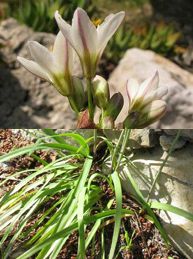
Over the last few years this plant has spread around the Botanic Garden especially through the monocot family beds and the Iris beds. On the tour was Margaret Waddy, the group secretary, and the following week in an evening talk that she gave, Margaret mentioned this pestilent plant. In the audience of her talk was Roger Balls who is an independent engineering consultant specialising in food processing, packing facility design, food hygiene, post harvest technology and horticultural production. For many years he has worked with a colleague, Dr Mike Diprose of Spectrum-tec to investigate the use of electricity to control weed plants.
Electrical weed control involves the application of very high voltage, short duration pulses or high voltage AC or DC current directly to the unwanted plants. It is environmentally friendly, leaving no harmful residues and although it has been practised for over 100 years it has not become a widely established means of weed control - possibly due to lack of suitable equipment and unfamiliarity. However, as more chemicals are removed from regulated use, alternative herbicide control methods are needed. Electrical weed control is another option.
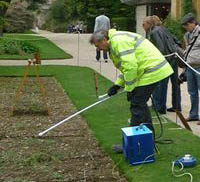
In the initial tests we treated some areas of Oxalis corniculata that were growing within paving in the conservatory. This area is used very heavily by school groups and so we do not like to use glyphosate and other synthetic herbicides in this space. Since the one-off treatment, no Oxalis has regrown. This highlights the benefits in not having to restrict visitor access outside the actual treatment periods. The beds to be cleared only need to be closed off while being treated, for maybe half an hour, then anyone can access them and there are be no harmful effects if a visitor touches a treated plant.
The outside test areas have been treated on subsequent occasions with the same voltages and on each occasion thus far we have seen some regrowth. However, since these tests were carried out we have had the results mentioned above and so it does not seem surprising that we have had regrowth. The real test will come when we do a recount of the infestation levels in the bed next Spring. Do we have significantly fewer bulbs per cubic metre of soil?
Electrical weed control is certainly an option for the future. We found it easy to use, the results on Oxalis were very promising but the jury is still out on the noxious Nothoscordum.
Alison Foster
Oxford Botanic Garden
Plant of the Month
Coronilla valentina ssp. glauca 'Citrina', bastard senna, crown vetch, Fabaceae
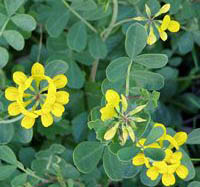
The crown vetch flowers from summer right through the winter but it is on dreary wintery days that you really notice the beauty of it. The flowers have a beautiful scent that brightens the winter. Garden writer Val Bourne describes it as 'a sweet narcissi fragrance more reminiscent of spring than a dark, dank November day.' Other great gardeners who have favoured this plant include Vita Sackville-West. She described coronilla as 'flowering continuously between those two great feasts of the Church - a sort of hyphen between the Birth and the Resurrection.'
Alison Foster
Oxford Botanic Garden
Medicinal Plant of the Month
Ulex europaeus, Gorse, Fabaceae
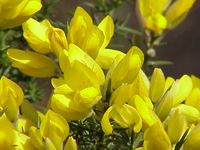
Gorse seeds contain one of a special group of chemicals called lectins. These chemicals can be used to assist with the determination of a person's blood type (A, B, AB, O etc.). Plant lectins were first discovered in 1888 when Stillmark discovered that an extract from the seed of the castor oil plant (Ricinus communis) caused red blood cells to clump together. Over the next decades more and more of these molecules were found in plants, not all of them as toxic as those from the castor bean. In the 1940s it was then discovered that some of these molecules affected blood cells from some individuals within the ABO blood group system but not others. It was at this point that the term lectin was coined. In Latin legare means to collect, pick up, select. Lectus, (-a, -um) means chosen, selected one.
Lectins are proteins that can bind selectively and reversibly to complex sugar containing molecules. There are many, diverse applications of lectins in medical research and there is much active research in this area. In fact there is a whole company devoted to commercialising the medical uses of lectins in areas as diverse as ulcer treatments, prevention of HIV transmission and acne treatment. Lectins are also used to determine blood type - within the ABO blood group system.
Gorse lectin is a commercial product used by researchers. This is what the Aldrich catalogue says about it 'Ulex europaeus agglutinin has anti-H blood group specificity. There are two types of lectin: UEA I has an affinity for L-fucose and UEA II has an affinity for N,N'-diacetylchitobiose. The mol. wt. of UEA I was initially found to be 170,000 daltons. Later reports indicate that UEA I may form aggregates at neutral and basic pH and that the correct mol. wt. is 68,000 daltons.'
Alison Foster
Oxford Botanic Garden
News from our Associates

BIAC is holding their annual Young Consultant of the year Presentation on Tuesday 17 January 2012 in the Library of the Minerals & Mining Institute, 1 Carlton Terrace, London SWY 5DB at which Poul Christensen Chairman of Natural England has agreed to speak. This event is open to BIAC and non BIAC members and to attend please contact the BIAC office at info@biac.co.uk.
Commercial Horticultural Association

There are still last minute opportunities for a presence at Salon du Végétal 2012, France's premier international event for horticultural professionals. Potential grant support of £1000 is available for eligible companies.
The Association is also putting together a trade mission to Kenya to coincide with the new IFTEX trade show in Nairobi. As well as visiting the show, delegates will visit the growing areas around Naivasha and attend a reception for local business leaders at the British High Commission. Contact the CHA at stuart@cha-hort.com for more details of both.
Society of Biology

The Society has also submitted a response to the Science and Technology Select Committee inquiry on Science and International Development.
Horticulture Industry News
For the very latest horticultural news follow us on Facebook and or
Twitter.
Low pesticide rates may hasten the evolution of resistance
An article in Pest Management Science suggests that at very low pesticide rates, a certain low proportion of pests may receive a sub-lethal dose, are highly stressed by the pesticide and yet survive. Stress is a general enhancer of mutation rates. Thus, the survivors are likely to have more than normal mutations, which might include mutations leading to pesticide resistance, both for multifactorial (polygenic, gene amplification, sequential allelic mutations) and for major gene resistance. Management strategies should consider how to eliminate the subpopulation of pests with the high mutation rates, but the best strategy is probably to avoid too low application rates of pesticides from the outset. More
Molecular 'maturation clock' modulates branching in tomato plants
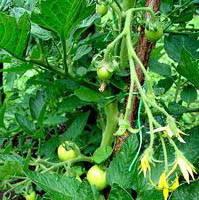
Depending on the tomato variety, inflorescences can be a simple cyme or have multiple branches. Although most varieties produce a single inflorescence branch with just a few flowers, some varieties make dozens of branches bearing hundreds of flowers. 'Although one might think that all this branching is good, too much branching is not a desirable trait, because the plant spends so much energy on making flowers on those branches that it ends up not having the resources to set those flowers into fruits,' explains Lippman. 'So there needs to be a balance, which the wild relatives of tomatoes seem to have achieved.' More
Metarhizium robertsii stimulates plant root development
Metarhizium robertsii is a soil-inhabiting insect-pathogenic fungus but also colonizes plant roots endophytically, thus showing potential as a plant symbiont. Research now shows that M. robertsii conidia adhered to, germinate on, and colonize roots. Furthermore, plant roots treated with Metarhizium grew faster and the density of plant root hairs increased when compared with control plants.
The onset of plant root hair proliferation was initiated before germination of M. robertsii on the root (within 1-2 d). Metarhizium appeared as a mycelial aggregate within root cortical cells as well as between the intercellular spaces with no apparent damage to the plant. These results suggest that M. robertsii is not only rhizosphere competent but also displays a beneficial endophytic association with plant roots that results in the proliferation of root hairs. More
Towards drought tolerance in crops
When plants encounter drought, they naturally produce abscisic acid, a stress hormone that helps them cope with the drought conditions. The hormone turns on receptors in the plants, resulting in a suite of beneficial changes that help the plants survive. These changes typically include guard cells closing on leaves to reduce water loss, cessation of plant growth to reduce water consumption and a myriad other stress-relieving responses.
Working on Arabidopsis, a research team has now succeeded in supercharging the plant's stress response pathway by modifying the abscisic acid receptors so that they can be turned on at will and stay on. More.
Nitrogen-supplying bacteria given special access pass
A 120-year debate on how nitrogen-fixing bacteria are able to breach the cell walls of legumes has been settled. Whether the bacteria breach the cell walls by producing enzymes that degrade it, or the plant does the work for them, has been contested since an 1887 paper in which the importance of the breach was first recognised. John Innes Centre scientists now report that plants themselves allow bacteria in. 'Our results are so clear we can unequivocally say that the plant supplies enzymes to break down its own cell walls and allow bacteria access,' said Professor Allan Downie, of the John Innes Centre.
The ultimate aim is to enable non-legumes, and possibly even cereals such as wheat and rice, to develop the symbiosis and source their own nitrogen from the air like legumes. More
Plants emit oil of wintergreen to deal with stress
For years, scientists have known that many plants produce methyl salicylate commonly known as Oil of Wintergreen. But researchers had never before detected methyl salicylate in an ecosystem or verified that plants emit the chemical in significant quantities into the atmosphere. In part of an experiment to monitor plant emissions of certain volatile organic compounds (VOCs) scientists in California found that the emissions of VOCs included methyl salicylate. The levels of methyl salicylate emissions increased dramatically when the plants, which were already stressed by a local drought, experienced unseasonably cool night-time temperatures followed by large daytime temperature increases.
Instruments mounted on towers about 100 feet above the ground measured up to 0.025 milligrams of methyl salicylate rising from each square foot of forest per hour. The researchers speculate that the methyl salicylate has two functions. One of these is to stimulate plants to begin a process known as systemic acquired resistance, which is analogous to an immune response in an animal. This helps a plant to both resist and recover from disease. More
Note: Methyl salicylate (Methyl 2-hydroxybenzoate) is chemically quite different to aspirin (Acetylsalisylic acid or 2-acetoxybenzoic acid) and references in this article to aspirin should be ignored.
Why buttercups reflect yellow on chins
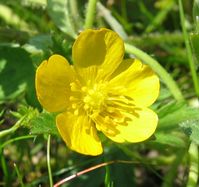
This new study shows how the buttercup's exceptionally bright appearance is a result of a special feature of the petal structure. The epidermal layer of cells has not one, but two extremely flat surfaces from which light is reflected. One is the top of the cells, the other exists because the epidermis is separated from the lower layers of the petal by an air gap. Reflection of light by the smooth surface of the cells and by the air layer effectively doubles the gloss of the petal.
Thermotherapy rids azaleas of deadly fungal disease
Research has indicated that simply submerging terminal leafy cuttings of 'Gumpo White' azalea in 50°C water for 21 minutes eliminates binucleate Rhizoctonia species from plant tissues. Now, in a broader study researchers have concluded that 'Despite the risks imposed by submersing azalea cuttings, we found all 12 cultivars tested to be tolerant of submersion durations long enough to eliminate binucleate Rhizoctonia species from stem and leaf tissue with only a low likelihood of sustaining detrimental damage'.
They concluded that hot water treatment provides an alternative and effective disease control method for eliminating Rhizoctonia from azalea cuttings. 'Thermotherapy provides an example of how simple techniques may provide effective disease control when appropriately applied'. More
Asparagus benefits from X-ray treatment
A potential solution to vegetables' short market life may lie in x-ray irradiation. Fresh green asparagus has a very limited shelf life, due in part to the vegetable's high respiration rate which makes packing and storing asparagus especially challenging. Other factors, such as asparagus' tendency toward rapid moisture loss and its susceptibility to bacteria invasion, create additional concerns for producers.
A research team in Michigan has found that x-ray treatment significantly reduced aerobic bacterial and mould/yeast populations and helped to maintain sugar (glucose and fructose) levels in asparagus. The report noted that additional studies are needed to evaluate any nutritional or sensory changes to asparagus before commercial feasibility of the x-ray technology can be determined. More
Teagasc and Horticultural Development Company (UK) collaborate
Teagasc has signed a Memorandum of Understanding (MoU) with the Horticultural Development Company (HDC) in the UK, to increase the levels of co-operation and collaboration between the two organisations for the benefit of the horticulture sectors in Ireland and the UK. As part of the Teagasc plan for the development of horticulture 2010-2013 they identified the requirement for closer co-operation with similar organisations in other countries as central to maximising the flow of knowledge to the Irish horticultural sector.
This culminated in the MoU which allows for Teagasc and HDC to collaborate on development strategies for horticulture and on co-funding research projects of mutual interest. The two organisations will work to share and disseminate information from existing and future research for the benefit of horticultural producers in Ireland and the UK. This could include joint publications and jointly run open days, conferences, and seminars.
Scientists forecast crops that adapt to changing weather
Scientists at the University of Edinburgh studying how tiny algae renew old or damaged cell proteins say their findings could be useful in developing crops suited to climates in which weather changes quickly. They found that the speed at which protein renewal takes place dictates how quickly they can adapt to environmental changes, such as a sudden frost or drought.
The team found that renewal rates vary between proteins according to their role and their location within cells. Proteins that carry out photosynthesis - the process that converts sunlight into energy - renew quickly because they are at risk of light damage. Conversely, proteins that protect DNA in plant cells are at little risk of damage, and renew slowly. The findings could help breed crops incorporating proteins that respond quickly to changing conditions. More
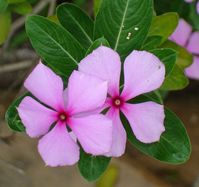
Research at two Malaysian Universities has found that cancer could be treated at a lower cost by using the extracts from herbal plants which are locally known as 'misai kucing' (Orthosiphon stamineus or Java tea) and 'kemunting Cina' (Catharanthus roseus or Madagascar periwinkle) can help in the treatment of cancer More.
Note: Catharanthus is the source of vincristine and vinblastine which are used as cancer drugs.
Plant seeds protect their genetic material against dehydration
Researchers from the Max Planck Institute for Plant Breeding Research in Cologne have discovered that the genetic material in seeds becomes more compact and the nuclei of the seed cells contract when the seeds begin to mature. The seeds probably protect their genetic material against dehydration in this way. The genes in the cell nucleus are surrounded by proteins. This complex - the chromatin - can be tightly or loosely packed.
The degree of compactness of the chromatin regulates the activity of the genes: the more 'open' the chromatin, the better the genes can be read. It was not known up to now whether the reduced metabolic activity or low water content of seeds was linked with changes in the chromatin. The research team has now shown that the cell nuclei clearly contract during seed maturation and the chromatin compacts as part of this process. Both processes are reversed during germination. More
Events Calendar
Other Events of Interest
International Symposium on Orchids and Ornamental Plants
9 - 13 Jan, International Society for Horticultural Science
Chiang Mai, Thailand
International Advances in Pesticide Application
10 - 12 Jan, Association of Applied Biologists
Wageningen, The Netherlands
All Africa Horticultural Congress
15 - 20 Jan, International Society for Horticultural Science
Skukusa, South Africa
Brassica Growers Association Conference & Exhibition
17 Jan, Brassica Growers Association
Grange-de-Lings, UK
New research into plant colour production
19 Jan, Bristol Botanic Garden
Bristol, UK
Harrogate Week
22 - 26 Jan, British & International Golf Greenkeepers Association
Harrogate, UK
International Symposium on Banana
23 - 26 Jan, International Society for Horticultural Science
Chiang Mai, Thailand
IPM Essen
24 - 27 Jan, Messe-Essen
Essen, Germany
A Garden for a Thousand Years
26 Jan, Oxford Botanic Garden
Oxford, UK
Managing Pesticides in Fresh Produce
31 Jan, Practical Solutions International
Arundel, UK
Fruit Logistica
8 - 10 Feb, Messe Berlin
Berlin, Germany
The Gardens of Singapore
9 Feb, Oxford Botanic Garden
Oxford, UK
Bacterial Diseases of Stone Fruits and Nuts
14 - 17 Feb, International Society for Horticultural Science
Zurich, Switzerland
Early spring flowering perennials
16 Feb, Bristol Botanic Garden
Bristol, UK
International Strawberry Symposium
18 - 22 Feb, International Society for Horticultural Science
Beijing, China
Salon du Vegetal
21 - 23 Feb, Bureau Horticole Régional des Pays de la Loire
Angers, France
Quality Management in Postharvest Systems
21 - 24 Feb, International Society for Horticultural Science
Bangkok, Thailand
Quality Management in Supply Chains of Ornamentals
21 - 24 Feb, International Society for Horticultural Science
Bangkok, Thailand
Postharvest Pest and Disease Management in Exporting
21 - 24 Feb, International Society for Horticultural Science
Bangkok, Thailand
Postharvest Quality Management of Root and Tuber Crops
21 - 24 Feb, International Society for Horticultural Science
Bangkok, Thailand
Gardening is happiness-window boxes to the president of the RHS
23 Feb, Oxford Botanic Garden
Oxford, UK
Grower of the Year Awards
23 Feb, Haymarket Media
London, UK
World Food Technology and Innovation Forum
29 Feb - 1 Mar, World Trade Group
Dublin, Ireland
The
Royal Garden Academy in Berlin: The revival of German horticulture
8 Mar 2012, Oxford Botanic Garden
Oxford, UK
Hortec, Kenya
POSTPONED, ECO
Nairobi, Kenya
Flora
of the Avon Gorge
15 Mar 2012, Bristol Botanic Garden
Bristol, UK
The Landscape
Show
15 - 17 Mar 2012
London, UK
International
Congress on Hazelnut
19 - 22 Mar 2012, Instituto de Investigaciones Agropecuarias
Temuco, Chile
Flowers
& Hortec Poland
20 - 22 Mar 2012, BTO Exhibitions
Warsaw, Poland
International
Flower Trade Expo
21 - 23 Mar 2012, HPP Exhibitions
Nairobi, Kenya
Meadows
at the Olympic park: elysium in the east end?
22 Mar 2012, Oxford Botanic Garden
Oxford, UK
Medicinal and Aromatic
Plants
22 - 24 Mar 2012, International Society for Horticultural Science
Djerba, Tunisia
Biotechnology
of Fruit Species
25 - 29 Mar 2012, International Society for Horticultural Science
Nelson, New Zealand
Hunting
for sustainability: ecology, economics and society
26 - 28 Mar 2012, Instituto de Investigación en Recursos
Cinegéticos
Ciudad Real, Spain
Crop
World North America
27 - 28 Mar 2012,
Charlotte, USA
IPM
on the World Stage-Solutions for Global Pest Challenges
27 - 29 Mar 2012,
Memphis, USA
New
Ag International Conference & Exhibition
28 - 30 Mar 2012
Bangkok, Thailand
Advances
in Plant Virology
28 - 30 Mar 2012, Association of Applied Biologists
Dublin, Ireland
Flower Bulbs and
Herbaceous Perennials
28 Mar - 1 Apr 2012, International Society for Horticultural Science
Antalya, Turkey
If you would like to advertise a forthcoming event please contact. monica.ugalde@soci.org.
Horticulture Group Contact Details
For submitting ideas or to volunteer to be part of a committee or a group, please contact:
Chairman - Peter Grimbly
Meetings Secretary - Alison Foster
Minutes Secretary - Margaret Waddy
Newsletter co-ordinator - Sue Grimbly scihortigroup@btinternet.com
Group Contact - Monica Ugalde monica.ugalde@soci.org T: +44 (0)20 7598 1594
